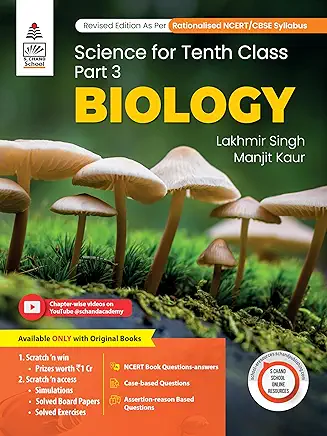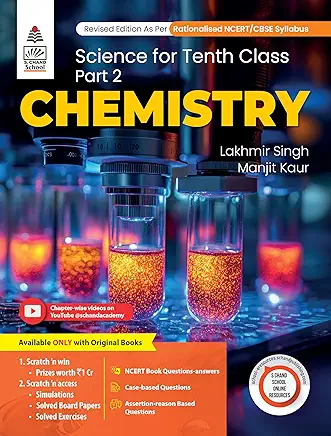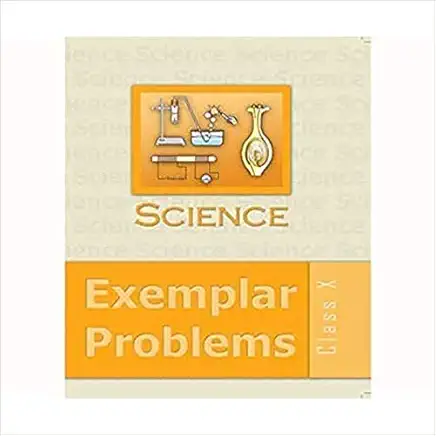CBSE Class 10 Biology: Our Environment - Part 5: Assertion-Reason
Welcome to Part 5 of our 8-part series on Our Environment. This post focuses on Assertion-Reason (A/R) Questions. These questions test your in-depth conceptual understanding and your ability to link two related statements.
Recommended Books for Deep Practice
Top 25 A/R Questions - Our Environment
Question 1: Decomposers
Assertion (A): Decomposers act as cleaning agents of the environment.
Reason (R): Decomposers break down dead and decaying organic matter into simple inorganic substances.
Question 2: Biodegradable Waste
Assertion (A): Biodegradable wastes, like vegetable peels, should be composted.
Reason (R): Composting converts biodegradable waste into nutrient-rich humus, which pollutes the soil.
Question 3: Energy Flow
Assertion (A): The flow of energy in a food chain is unidirectional.
Reason (R): Energy flows from the sun to producers, then to consumers, and is not recycled back to the sun.
Question 4: Ozone Layer
Assertion (A): The ozone layer protects life on Earth by absorbing harmful ultraviolet (UV) radiation.
Reason (R): Ozone (O₃) is formed in the stratosphere by the action of UV radiation on oxygen (O₂).
Question 5: Food Chain Length
Assertion (A): Food chains are generally limited to three or four trophic levels.
Reason (R): According to the 10% energy law, the energy available at higher trophic levels is too small to support a population.
Question 6: Non-Biodegradable
Assertion (A): Plastic bags and glass bottles are non-biodegradable wastes.
Reason (R): They can be broken down by the action of microorganisms into simple, harmless substances.
Question 7: Biomagnification
Assertion (A): In a food chain, the concentration of harmful chemicals like DDT is highest at the top trophic level.
Reason (R): DDT is non-biodegradable and accumulates in the fat tissues of organisms at each trophic level.
Question 8: Trophic Levels
Assertion (A): In a food chain, a deer is a primary consumer.
Reason (R): A deer feeds on plants, which are producers.
Question 9: Food Web
Assertion (A): A food web is a more stable system than a food chain.
Reason (R): A food web consists of a single, linear pathway of energy flow.
Question 10: Nutrient Flow
Assertion (A): The flow of nutrients in an ecosystem is cyclic.
Reason (R): Decomposers return the nutrients from dead organisms back to the soil, where producers can use them again.
Question 11: Producers
Assertion (A): Green plants are called producers.
Reason (R): Green plants can make their own food using photosynthesis.
Question 12: CFCs
Assertion (A): The use of CFCs (Chlorofluorocarbons) is a major environmental concern.
Reason (R): CFCs cause the depletion of the ozone layer in the stratosphere.
Question 13: 10% Law Calculation
Assertion (A): If plants have 1000 J of energy, the lion in the food chain Grass -> Deer -> Lion will get 10 J of energy.
Reason (R): Only 10% of energy is transferred at each trophic level.
Question 14: Vegetarian Diet
Assertion (A): A vegetarian diet is more energy-efficient than a non-vegetarian diet.
Reason (R): When humans eat plants, they are primary consumers (T2), getting more energy than when they eat herbivores (T3).
Question 15: Aquarium
Assertion (A): An aquarium is an artificial ecosystem.
Reason (R): An aquarium is a man-made, self-sustaining ecosystem.
Question 16: Plastic Cups
Assertion (A): Disposable plastic cups are a better alternative to disposable paper cups.
Reason (R): Plastic cups are non-biodegradable and cause environmental pollution.
Question 17: UV Radiation
Assertion (A): UV radiation is harmful to living organisms.
Reason (R): UV radiation can cause skin cancer and cataracts in humans.
Question 18: Ecosystem
Assertion (A): An ecosystem consists of only the living organisms in an area.
Reason (R): An ecosystem is a functional unit of biotic and abiotic components.
Related Posts
Question 19: The 3 'R's
Assertion (A): "Reduce" is considered the best method in the 3 R's waste management strategy.
Reason (R): "Reduce" stops waste from being generated at the source, saving the most resources and energy.
Question 20: Trophic Level Removal
Assertion (A): If all producers in an ecosystem are removed, the entire ecosystem will collapse.
Reason (R): Producers are the only source of food energy for all consumers.
Question 21: Kulhads
Assertion (A): Using disposable kulhads (earthen cups) is a more sustainable alternative to plastic cups.
Reason (R): Making kulhads on a large scale leads to the loss of fertile topsoil.
Question 22: Autotrophs
Assertion (A): All organisms in an ecosystem are either producers or consumers.
Reason (R): Decomposers are a third type of organism that breaks down dead organic matter.
Question 23: Abiotic Components
Assertion (A): Air, water, and soil are abiotic components of an ecosystem.
Reason (R): Abiotic components are the non-living physical and chemical factors of an ecosystem.
Question 24: Producers' Energy
Assertion (A): Green plants capture 100% of the sun's energy that falls on their leaves.
Reason (R): Most of the sun's energy is reflected or lost as heat.
Question 25: Montreal Protocol
Assertion (A): The Montreal Protocol was an international treaty to ban ozone-depleting substances.
Reason (R): The Montreal Protocol was signed to control global warming by reducing CO₂ emissions.






